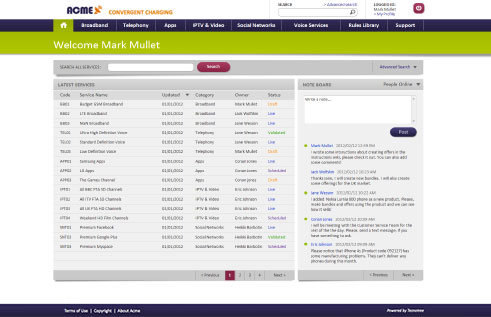By Martin Morgan*, Director of Marketing,
Openet
At the start of November this year, leading market research firm Infonetics released their survey on operators’ residential femtocell strategies. According to Infonetics, “operators are currently focused on quality of experience, leveraging femtos to deliver 5-bar voice coverage in the home and provide faster and more consistent broadband. The picture starts to change in a year or so when femtocell-based add-on services and applications become more prominent in the market”. Looking ahead, Infonetics believes that “by 2015, the focus shifts to leveraging the intelligence in the femtocell to offer a range of location-based, content-related, or presence-aware applications to drive higher ARPUs.”
Sound familiar? Its déjà vu all over again - using new technology to firstly gain network performance improvements and then leveraging the same technology to provide more segmented (and personalized) marketing offers and services based on powerful intelligence. This pretty much maps out the evolution of policy management. Remember when policy first appeared, the main use case was implementing fair use policies to help optimize network performance. Then came increased ‘product marketing’ use cases, such as tiered services (speed and volume), roaming, application and device service passes. Then, policy was integrated with charging to provide shared data plans, toll free content, dual persona offers and so on. Now the latest advance is using the data that mediation, policy and charging utilize to drive real-time intelligence. The news that Infonetics sees operators leveraging intelligence in femtos to offer contextual aware applications (which should deliver more value to consumers) by 2015 is to be welcomed. This means that the evolution from policy to PCC to ‘PCC plus intelligence’ is established, and using policy and charging to enable personalized offers based on network level intelligence will soon become a mainstream business process for operators.
It could be argued that the roll out of LTE and the ability to differentiate services based on speed was the catalyst for PCC being used as a marketing enabler. This was due to the increased data usage through a wide range of data led services, which led to an increase in the number of products and applications which provided more customer choice. The trend here is on-going; every week we see new service offers from operators. This leads to increased customer segmentation, and as customer expectations and competitive challenges advance, operators often have a very short time to get to market an increasing range of offers.

LTE is changing the speed at which operators do business. Increases in sophistication in customer behavior are radically changing how operators develop and market their services. The immediacy of customers’ data experience is resulting in the continuous marketing loop of analyzing behavior, developing offers, launching and promoting services, and back to campaign measurement at a faster rate than ever before (see figure 1). Add new services from partners in to the mix and the process becomes more complex, as well as faster. New offers and services development are becoming increasingly dynamic, as operators continue to develop their pricing and product strategies based on value, rather than be involved in a race to the bottom by selling a generic commodity. As operators look at how to best monetize these new and enhanced services, they are looking at the pricing and packaging flexibility that exists in legacy BSS systems and asking if they provide the flexibility and fast time to market that dynamic data driven services will require.
Being able to sell services based on value (rather than just price) involves knowing that some services have more value to different people based on the customer context – e.g. who, what, when, where and what. Having this business intelligence in real-time and using it to drive offers to be presented to appropriate segments in real-time, direct to the device, is providing a significant opportunity to take advantage of the data that operators already have and use it to provide personalized, relevant marketing in real-time.
It took several years for policy to evolve the way it has. It’s now at the stage where it’s supporting a wide range of business-focused use cases, integrated with charging, and is being used as part of a solution driven by real-time network intelligence. The news that operators will roll out residential femtocells and will use intelligence from femtocells to enable contextual specific apps by 2015 just goes to show how PCC has evolved to be a central tenant, not just of BSS, but also of marketing and offer development.
__________

*With 25 years’ experience in mobile communications software, Martin has worked in mobile billing software since the early days of the industry. In that time he’s spoken at over 50 telecoms conferences worldwide and had a similar number of articles published in the telecoms trade press and served on trade association and company boards. At Openet Martin is responsible for marketing thought leadership and market interaction.
 A recent report by Cliff Grossner, Ph.D., directing analyst for data center and cloud, Infonetics Research, finds that "Though WAN optimization revenue increased 3% sequentially in 3Q13, to $210 million, it remains on an overall downhill course, with revenue falling 9% year-over-year this quarter. Future WAN optimization revenue will increasingly come from the replacement of existing gear rather than adoption by new customers or sites. As usual, Riverbed dominates the WAN optimization market, Cisco is firmly in 2nd place, and Blue Coat rounds out the top 3".
A recent report by Cliff Grossner, Ph.D., directing analyst for data center and cloud, Infonetics Research, finds that "Though WAN optimization revenue increased 3% sequentially in 3Q13, to $210 million, it remains on an overall downhill course, with revenue falling 9% year-over-year this quarter. Future WAN optimization revenue will increasingly come from the replacement of existing gear rather than adoption by new customers or sites. As usual, Riverbed dominates the WAN optimization market, Cisco is firmly in 2nd place, and Blue Coat rounds out the top 3". 















































